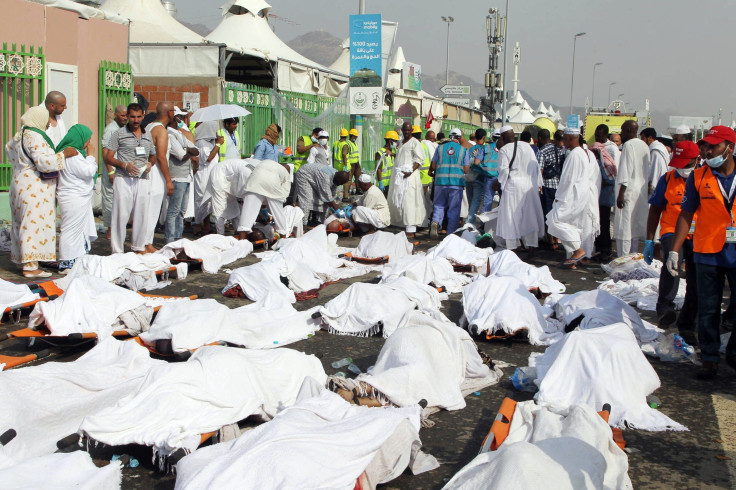Hajj Stampede Raises Questions About Saudi Infrastructure And Booming Religious Tourism Industry

A deadly stampede that killed at least 717 people and injured 863 others during the hajj, the Muslim holy pilgrimage, near Mecca on Thursday has raised concerns over whether the Saudi government has done enough to develop the necessary infrastructure and security to accommodate the 2 million people who take part in the world’s largest mass migration each year.
As the number of middle-class Muslims in the world has grown -- in 1950, fewer than 100,000 people made the journey, while about 2 million attend today -- critics say the government has focused more on developing a religious tourism industry that prizes extravagant hotels and shopping malls surrounding Mecca over the safety and proper capacity for the event.
“However much the Saudi government does to improve its infrastructure of hotels and airports, they face great theological obstacles to changing the hajj itself,” said Nile Green, author of “The Hajj as Its Own Undoing: Infrastructure and Integration on the Muslim Journey to Mecca” and a professor of history at UCLA. “Since this is only the latest of many such stampedes, it is therefore hard to imagine it will be the last.”
An annual pilgrimage that occurs during the 12th month of the Islamic lunar calendar, the hajj is considered a requirement of all able-bodied Muslims who can afford to make the trip at least once in their lives. It takes place over five days and consists of a series of ancient rites associated with the prophets Muhammad and Abraham. Among them, pilgrims circumambulate the Kaaba, a black cuboid structure at the center of the Grand Mosque in Mecca, and travel by foot between several holy sites in the area.
“The hajj has a sacred geography and set of rituals that took shape when Muslims were merely a small community in Arabia,” Green said. “Since the rise of steamships, and then airplanes, those innate constraints have been under increasing pressure.”
A Tradition Turns Deadly
Thursday’s stampede occurred because of a crowd surge during “the stoning of the devil,” a tradition in which pilgrims stand on the Jamaraat Bridge and throw pebbles at a pillar in the tent city of Mina, some 2 miles from Mecca. It was the deadliest stampede since 1990, when more than 1,400 pilgrims were killed in a pedestrian tunnel linking Mecca and Mount Arafat. But in between, there have been similar events. In 2004 and 2006, similar stampedes occurred on the Jamaarat Bridge killing a total of 612 people. And just two weeks ago, a construction crane collapsed, crashing into the Grand Mosque in Mecca, claiming more than 100 lives.
And while Saudi officials have invested money in shoring up infrastructure throughout the hajj sites -- they rebuilt the Jamaraat Bridge into a multilevel structure after the disaster in 2006 -- experts say the kingdom has prioritized attracting more wealthy pilgrims with high-end hotels and retail outlets in an effort to support its lucrative religious tourism industry.
“The scale of hajj and plans for future growth is all wrong,” said Seán McLoughlin, a lecturer at the University of Leeds who has researched British Muslims’ experiences of the hajj. “This event raises serious questions about whether the intended growth, the future Saudi strategy for expansion, is viable and feasible. It problematizes the whole religious tourism strategy that the Saudis seem to be developing.”
When Religion Is Big Business
That strategy is evident in Mecca’s construction boom over the past 15 years, which has resulted in a skyline that boasts malls, fancy hotels and gaudy skyscrapers like the Abraj Al-Bait towers, a complex of seven buildings featuring a 1,972-foot clock tower in the center -- one that many who want to preserve the history of Mecca find distasteful. Such tourism is a reliable profit center for the country, raking in nearly $20 billion a year.
“There’s no doubt the Saudis, in the context of oil prices going up and down, are looking to develop this business,” said McLoughlin.
Saudi officials say they are working to find the cause of the accident. Saudi Crown Prince Mohammed bin Nayef called an emergency meeting in which he ordered an investigation of the stampede. But another official, Saudi health minister Khalid al-Falih, blamed the event on pilgrims who didn’t “respect the timetables” of movement set by hajj authorities.
Critics from around the world aren’t buying it. Iran’s Ayatollah Ali Khameini said the “government of Saudi Arabia must accept the huge responsibility for this catastrophe.”
And Madawi al-Rasheed, a visiting professor of the anthropology of religion at the London School of Economics, said greed underpins these disasters.
“The renovation and expansion are done under the pretext of creating more space for Muslim pilgrims, but it masks land grabs and vast amounts of money being made by the princes and by other Saudis,” said al-Rasheed. “There is no accountability. It’s shocking that almost every year there is some kind of death toll.”
© Copyright IBTimes 2024. All rights reserved.











